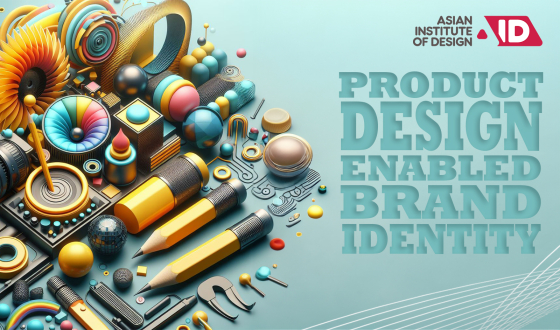The Role of Product Design in Brand Identity and Recognition

The Role of Product Design in Brand Identity and Recognition
We have arrived at a highly competitive and dynamic business landscape, where establishing a distinctive brand identity is crucial for success. A brand is not just a logo or a name; it is the sum of all the experiences and perceptions that consumers associate with a company. One integral element of building a powerful brand identity is Product Design.
The way a product looks, feels, and functions can significantly impact how consumers perceive and recognize a brand. In this article, we will explore the intricate relationship between product design, brand identity, and brand recognition, shedding light on why investing in thoughtful and strategic product design is essential for businesses aiming to thrive in the market.
Defining Brand Identity
Before delving into the role of product design, it is important to understand what brand identity entails. Brand identity is the visual, verbal, and emotional representation of a brand. It encompasses the brand’s personality, values, and promises to its customers. A well-defined brand identity serves as the foundation for creating a strong and lasting connection with the target audience.
The components of brand identity include:
Logo and Visual Elements: The logo is often the most recognizable visual element of a brand. It should be distinctive, memorable, and reflective of the brand’s personality.
Color Palette: Colors evoke emotions and play a significant role in brand perception. Consistent use of colors across various brand elements fosters recognition.
Typography: The choice of fonts contributes to the brand’s personality. Consistent typography creates a cohesive and recognizable brand image.
Brand Voice: The way a brand communicates, both in written and spoken form, contributes to its identity. Whether formal, casual, or humorous, the brand voice should align with its values.
Mission and Values: Clearly defined mission and values help establish the brand’s purpose and build trust with consumers who share similar values.
The Power of First Impressions: How Product Design Shapes Perception
In a world saturated with choices, consumers make split-second decisions based on visual appeal and perceived value. Product design, encompassing the physical appearance, functionality, and overall user experience, plays a pivotal role in shaping these first impressions.
Visual Appeal: A product’s visual design is often the first thing consumers notice. Whether it’s the sleek lines of a smartphone, the elegant packaging of a luxury item, or the playful design of a children’s toy, the aesthetics of a product set the stage for how consumers perceive the brand. Consistency in design across product lines reinforces brand identity.
Quality Perception: The quality of product design directly influences how consumers perceive the quality of the brand as a whole. A well-designed and well-made product communicates a commitment to excellence, instilling confidence in the brand. Conversely, a poorly designed product can raise doubts about the brand’s overall quality and reliability.
User Experience: Beyond visual appeal, the overall user experience is a critical aspect of product design. Intuitive interfaces, ergonomic shapes, and seamless functionality contribute to positive user experiences. When consumers enjoy interacting with a product, they are more likely to form positive associations with the brand.
Differentiation: In crowded markets, differentiation is key. Unique and innovative product design sets a brand apart from its competitors. Apple, for example, has become synonymous with sleek and minimalist design, differentiating itself in the tech industry.
Product Design as a Brand Extension
Product design is not isolated from the rest of a brand’s identity; rather, it serves as a tangible extension of the brand. Each product a company releases is an opportunity to reinforce its values, personality, and promises. When done strategically, product design creates a cohesive brand narrative that resonates with consumers.
Aligning with Brand Values: A company that values sustainability, for instance, can incorporate eco-friendly materials and practices into its product design. This alignment reinforces the brand’s commitment to its values, creating a narrative that consumers can connect with on a deeper level.
Consistency Across Product Lines: While each product may have unique features, there should be a consistent design language that ties all products together. This visual continuity across the product portfolio reinforces brand recognition and strengthens the overall brand identity.
Evolution and Adaptation: As market trends and consumer preferences evolve, so too should a brand’s product design. Successful brands navigate the balance between maintaining a recognizable identity and adapting to stay relevant. The evolution of the iPhone design over the years is a prime example of a brand adapting to changing trends while retaining its core identity.
Building Emotional Connections Through Design
Beyond functionality and aesthetics, product design has the power to evoke emotions and create lasting connections with consumers. Emotional branding is a strategy that leverages the power of emotions to build a strong and loyal customer base. Product design, with its ability to tell stories and elicit emotions, is a crucial tool in the emotional branding toolbox.
Storytelling Through Design: Every product has a story, and the design is the medium through which that story is told. Whether it’s the craftsmanship of a handmade item or the cutting-edge technology behind a gadget, product design communicates the narrative of the brand’s journey and values.
Creating Memorable Experiences: Products that go beyond meeting functional needs to create memorable experiences leave a lasting impression. Consider the unboxing experience of Apple products or the sensory delight of opening a luxury cosmetic package. These experiences contribute to the emotional connection consumers have with the brand.
Cultural and Social Relevance: Product design can also tap into cultural and social trends, making a brand more relatable and relevant. Brands that understand and reflect the values of their target audience through design can create a sense of belonging and community.
The Role of Product Design in Brand Recognition
Brand recognition is the extent to which consumers can identify and recall a brand based on its visual or auditory cues. Strong brand recognition is a valuable asset for businesses, as it can lead to increased customer loyalty, trust, and a competitive edge in the market. Product design is a critical factor in achieving and enhancing brand recognition.
Distinctive Visual Elements: Consistent use of distinctive visual elements in product design contributes to brand recognition. The iconic “swoosh” of Nike or the golden arches of McDonald’s are examples of visual elements that have become synonymous with their respective brands.
Logo Integration: Incorporating the brand logo seamlessly into product design reinforces brand identity. A well-placed logo on a product serves as a constant reminder of the brand, contributing to increased recognition over time.
Packaging as a Brand Ambassador: The packaging of a product is often the first point of physical contact between the consumer and the brand. Thoughtful and consistent packaging design enhances brand recognition on store shelves and in the hands of consumers.
Consistency Across Touchpoints: Brand recognition is strengthened when consumers encounter consistent design elements across various touchpoints, including products, advertising, websites, and social media. This consistency creates a unified and memorable brand image.
Case Studies: Exemplifying the Impact of Product Design on Brand Identity
To illustrate the real-world impact of product design on brand identity and recognition, let’s explore two case studies from different industries.
1. Apple Inc.:
Apple is a prime example of a brand that has mastered the art of product design to build a strong and iconic brand identity. From the sleek and minimalist design of its hardware products to the intuitive user interfaces of its software, Apple products are instantly recognizable. The design philosophy, led by the late Steve Jobs, emphasizes simplicity, elegance, and a focus on the user experience.
The iPhone, Apple’s flagship product, has undergone several iterations, each building upon the design principles established with the first model. The seamless integration of hardware and software, coupled with a distinctive and minimalist aesthetic, has created a consistent and memorable brand identity. The Apple logo, a simple apple with a bite taken out of it, has become a globally recognized symbol of innovation and quality.
The success of Apple’s design-led approach is evident in its dedicated customer base, strong brand loyalty, and the premium pricing it can command for its products. Apple has demonstrated that product design is not just about creating functional devices but about crafting a holistic brand experience that resonates with consumers.
2. Coca-Cola:
In the beverage industry, Coca-Cola stands out as a brand with a timeless and universally recognized identity. While the core product is a beverage, Coca-Cola has successfully extended its brand identity through product design, packaging, and marketing.
The iconic contour bottle, introduced in 1916, is a testament to the brand’s commitment to design excellence. The distinctive shape of the bottle, coupled with the bold red color and the Coca-Cola logo, creates a visual identity that is instantly associated with the brand. The design of the bottle has become a cultural icon, symbolizing refreshment, enjoyment, and the Coca-Cola experience.
Beyond the bottle, Coca-Cola’s consistent use of red and white colors, coupled with the dynamic ribbon-like logo, reinforces brand recognition across a wide range of products and marketing materials. The brand’s ability to maintain a sense of nostalgia while adapting to modern trends has contributed to its enduring success in a highly competitive market.
Challenges and Considerations in Product Design for Brand Identity
While product design offers tremendous opportunities for building and reinforcing brand identity, it also poses challenges that businesses must navigate. Here are some key considerations:
Balancing Innovation and Consistency: Striking the right balance between innovation and maintaining a consistent brand identity is a delicate challenge. Brands must evolve to stay relevant, but abrupt departures from established design principles can alienate existing customers.
Cultural Sensitivity: In a globalized market, brands need to be culturally sensitive in their product design. Elements that resonate positively in one culture may have a different impact in another. Understanding cultural nuances is crucial to avoiding missteps that could harm the brand.
Adapting to Technological Advances: Rapid technological advancements can influence product design trends. Brands that embrace new technologies while staying true to their core identity can position themselves as innovators in the market.
Environmental Sustainability: With increasing awareness of environmental issues, consumers are placing greater emphasis on sustainable and eco-friendly products. Brands incorporating sustainable practices into their design not only contribute to a positive brand image but also align with consumer values.
Conclusion: The Enduring Impact of Strategic Product Design
In conclusion, product design is a powerful tool for shaping brand identity and recognition. Beyond serving functional purposes, well-designed products evoke emotions, tell stories, and create lasting connections with consumers. From the visual appeal of a product to the overall user experience, every design element contributes to the narrative of the brand.
Businesses that recognize the significance of product design in brand building invest not only in creating great products but also in crafting a cohesive and memorable brand experience. The case studies of Apple and Coca-Cola demonstrate that a thoughtful and strategic approach to product design can lead to enduring brand recognition, customer loyalty, and a competitive edge in the market.
As markets continue to evolve, brands must stay attuned to changing consumer preferences, technological advancements, and cultural shifts. By embracing innovation while staying true to their core identity, brands can leverage product design as a dynamic force that propels them forward in the ever-evolving landscape of business and consumer engagement. In a world where first impressions matter, product design stands as a beacon, guiding consumers toward a brand that not only meets their needs but also resonates with their values and emotions.
Similar Articles
-

Breaking Down the 7 Core UX Design Principles 04-07-2025
Ever wondered why certain apps or websites feel intuitive and effortle
-

Understanding the Different Types of Graphic Design 04-07-2025
Have you ever stopped to think about how much of the world around you
-

Mastering 2D and 3D Animation 03-04-2025
The Ultimate Career Boost in Today’s Creative Industry The demand fo
-

How to Make a Graphic Design Portfolio? 02-27-2025
Imagine walking into a room full of potential clients or employers, bu
